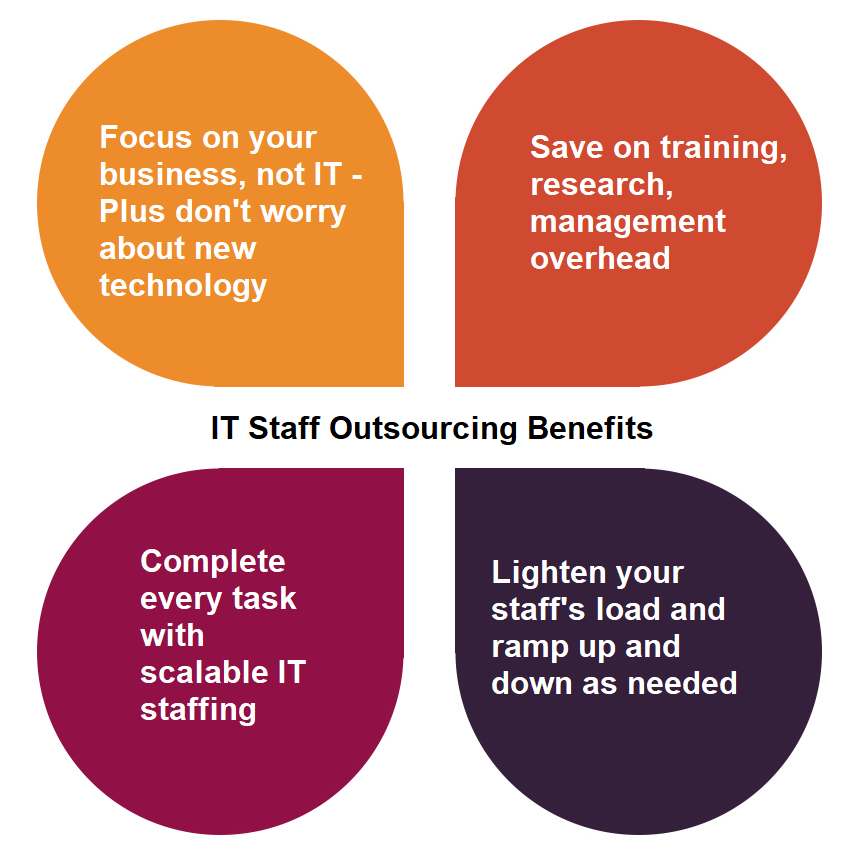Staff Augmentation vs. Outsourcing
It’s important for IT projects to be done right, on time, and within budget. Sometimes outsourced IT or staff augmentation can help get this accomplished. What is the difference between IT staff augmentation vs. outsourcing? There are some definite benefits to each model; deciding which is better will come down to your specific organization and its needs.
Staff Augmentation
Full-time employees can be expensive; you have to pay for salary, vacation, health insurance, training, and other benefits. Instead of hiring a full-time employee, staff augmentation gives you the opportunity to hire specialized technology professionals on a contractual basis. These professionals become part of your team for a certain time period or until a specific project is complete.
Staff augmentation allows an organization to increase and decrease resources when necessary, which enables you to meet changing needs and demands. Sometimes certain initiatives require special or unique skills, so staff augmentation allows you to add staff based on the additional skills needed for these initiatives.
Benefits of Staff Augmentation
- This option can be highly beneficial for unexpected events or if your staffing needs are constantly changing. With staff augmentation, you have the ability to increase or decrease resources based on demand.
- Staff augmentation allows you to leverage existing resources that you may already have with the help of external resources.
- Many organizations have gaps in specialty areas; staff augmentation allows you to use external expertise and skills to fill gaps and successfully complete IT projects.
- With staff augmentation, you can save on costs associated with hiring and training full-time employees.
- Staff augmentation allows you the ability to supervise and monitor the work being done.

Outsourced IT
IT project outsourcing is different from staff augmentation in that you offload a certain task or project to another company who has their own experts. After you provide any requirements, the other company takes over and gets the job done. Also known as Managed Services, outsourced IT is about achieving desired results. It can help organizations keep up with rapidly changing demands and even stay ahead of the curve.
Benefits of Outsourced IT
- Outsourced IT gives organizations the opportunity to focus on their existing resources and core operations.
- With external expertise, you can feel confident that the job will be done correctly according to the latest standards and best practices.
- Many outsourced companies have experts who keep tabs on the latest trends in technology, and they can use this knowledge to help keep your organization competitive in the marketplace.
- Since the outsourced company already has employees who are trained in specific areas, you can save money on internal training, plus you’ll save money on management overhead.
- Organizations with a small IT department or no IT department probably won’t have the internal capabilities to complete every task. It may be more cost effective to outsource these tasks, rather than hire and train new employees.
- Outsourcing certain tasks will help lighten your internal IT staff’s load and free them up to work on other strategic initiatives.
- The scalability and flexibility of outsourcing allows you to ramp up or down according to your business needs and market demands.

Want to learn more? There are various benefits of Managed Services.
Which Model Is Right For You?
While staff augmentation may be the right fit for one organization, outsourcing IT might be the right fit for another. Some organizations may find that some projects are better suited for staff augmentation, while other projects are better suited for outsourcing. If you need help deciding which model would be most beneficial for your organization, give us a call! Our technology experts will listen to your needs and help you decide what makes most sense for your specific requirements.
Date Posted: 4/23/18
Date Last Updated: 6/3/19
By: RTI Marketing Team




